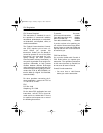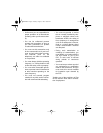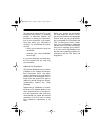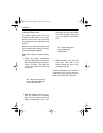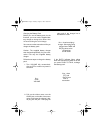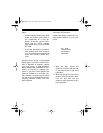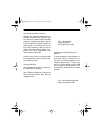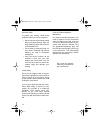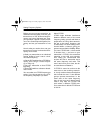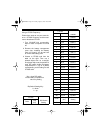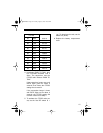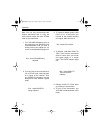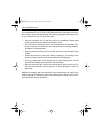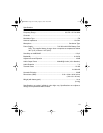
13
Setting Frequency Options
Before you can use your transceiver, an
authorized service facility must set your
transceiver to a VHF business band fre-
quency you have a license to use. Then,
you can select a preset CTCSS (Contin-
uous Tone Control Squelch System) fre-
quency and set your transceiver to use
it.
Here is what you need to do to set your
transceiver to use a business band fre-
quency and CTCSS.
þ
Send your transceiver to an authorized
service facility to have it set to a busi-
ness band frequency.
À
Set the DIP switches for a CTCSS fre-
quency (see “Using a CTCSS Frequen-
cy” on Page 14).
Ã
Set your transceiver to that CTCSS
frequency.
Õ
Set a DIP switch to activate or deacti-
vate CTCSS.
You can select one CTCSS frequency at
a time. If you do not want to use a CTC-
SS frequency, skip Steps 2
_
4 above.
About CTCSS
CTCSS helps eliminate interference
between different users of the same
frequency, letting you talk and listen to
people who are using other transceiv-
ers set to the same frequency and
CTCSS code. This is like having a sub-
channel within a channel, giving you
greater communication flexibility. When
you set a CTCSS code — there are 38
to choose from — and turn on your
transceiver’s CTCSS, the transceiver
transmits a tone with your transmis-
sion, letting you communicate with
anyone who has a transceiver set to
the same frequency and code. This
tone is too low for you to hear, but oth-
er transceivers can detect it.
If CTCSS is turned on and set to the
same tone on the receiving transceiv-
er, it only receives those transmissions
that include the tone. If two different
groups oper-ate transceivers in the
same area on the same frequency,
they do not hear each other’s broad-
casts if they both use CTCSS and
each select a different CTCSS tone.
Your transceiver’s default CTCSS tone
is 100 Hz.
19-1206.fm Page 13 Tuesday, August 3, 1999 10:50 AM



